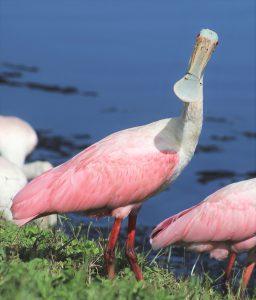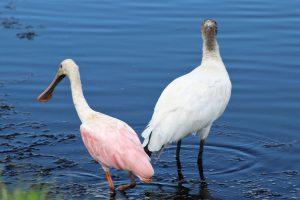For many years, I have loved the beautiful Roseate Spoonbill, which is actually a water bird. Since I never found one anywhere nearby, I sometimes traveled to Sanibel Island to watch them hunt the mudflats there.
Since then, the spoonbills have been gradually increasing their numbers, as well as increasing their range. The most exciting part of this is that they can now be found in some of the shallow lakes and wetlands of Osceola County.
Habitat
While coastal marshes and mangrove keys are still favored habitats for a spoonbill, inland lakes, marshes, and wetlands are now also being used. Any shallow body of water with a muddy bottom is an attractive hunting area for these birds.
Food
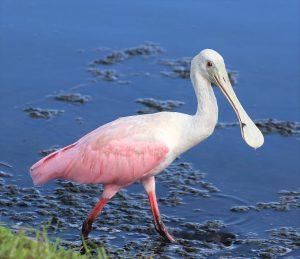
Hunting is done by submerging the spoon-shaped bill into the water and quickly moving it from side to side. Small fish, crayfish, crabs, aquatic invertebrates, aquatic insects, mollusks, and slugs are caught and eaten.
Description
The pink feather color is thought to be caused by the crustaceans and other invertebrates in their diet, which are high in carotenoids. Eventually, even the eyes and legs can become reddish. More often, the eyes appear to be brown.
The spoonbills become pinker as they age, with young birds starting out being pretty white. The body stays white, with the wings and undersides changing to a deep pink over time. A few red markings are seen on wings during flight. A mature spoonbill will be 2 1/2 to 4 feet long, with a wingspan of 4 to 5 feet. This makes spotting one of these birds pretty easy.
More about them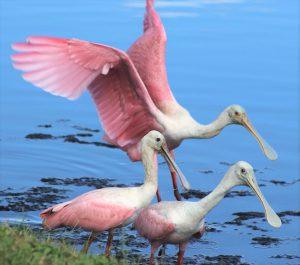
Spoonbills are usually seen in groups. But for some reason, I will sometimes see a lone spoonbill spending its day foraging with a stork, which also hunts the muddy areas. While a spoonbill is not a sma
ll bird, the stork is even larger. The birds travel fairly quickly as they wade through the lower areas of the shallows with bills submerged. The stork may stop briefly to unbury some creature and pry it loose with its long bill. Both birds often end up with pieces of aquatic plants wrapped around their bills, and the legs and feet can temporarily get pretty muddy. But in spite of spending their days in the mud, the birds still look surprisingly clean.
Spoonbill nesting is often done in trees, from 5 to 15 feet above the ground. If no suitable tree is available, nests can be on the ground. The newly hatched birds do not yet have the spoon shaped bill, but the transformation begins after 9 days. The offspring will stay in the nest for 5-6 weeks. Within 7-8 weeks, they will be able to fly.
Hopefully the spoonbills will continue to increase their numbers, as they retain their status as a state threatened species.
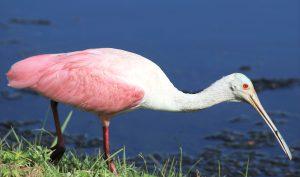
Photographing a spoonbill is a bit challenging.
As with most birds, it is necessary to creep around silently, and then to not move. Once a spoonbill is spotted, it can be tricky to catch a photo in which the bill is not underwater. It helps if the shoreline is not to their liking in places, causing them to walk on dry land for a short distance. While the spoonbills are capable of swimming, they choose not to unless absolutely necessary.
Wood stork hunting with Spoonbill
ALL PHOTOS BY SANDI SWITEK
Need more information:
For more information about Florida Friendly Plants and Wildlife you can email me at epabon5@ufl.edu or like us to learn about new classes or events at Gardening in Central Florida
By: Sandy Switek since 2005 and Eva Maria Pabon Residential Horticulture Agent
Do you want to read more about gardening? Follow our blog Eva Pabon, Author at UF/IFAS Extension Osceola County (ufl.edu)
Source: UF/IFAS Pest Alert
Note: All images and contents are the property of UF/IFAS.

